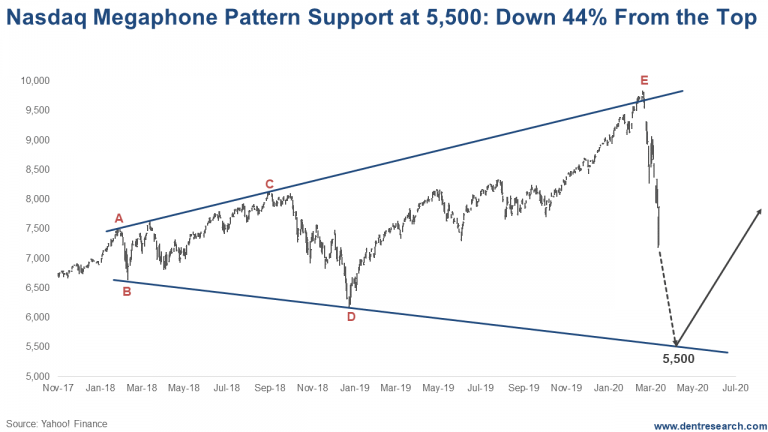In China for the last two months, retail sales are down 21%, industrial production is down 13%, and fixed investment is down 25%. The travel, restaurant and entertainment industries both in the U.S. and worldwide have been absolutely decimated with more to come…
And Treasury Secretary Steven Mnuchin says this won’t cause a recession and it’s not like 2008, so there will be a strong rebound… Even if you love Trump, you can’t like the unforgivable denial here. I see a definite recession in the second quarter, down around 5% or so, and it could continue into the third quarter.
The Spanish Flu of 1918 exploded due to the suppression of the news and the close encounters in Europe of World War I… and it had three surges: a small one in July 2018, then the big one in October/November and a final one into the following February. It infected around 500 million people and killed 20-50 million, 5% of the population – way more than all the deaths in World War I.
Goldman Sachs just had a massive call with its corporate customers saying that this could infect 50% of Americans, over 150 million and 70% of northern European countries like Germany… 3 million deaths in the U.S. alone. They see it peaking around mid-May, but if it doesn’t hit “herd immunity” with such massive infections by then, it could return next fall/winter to finish the task.
This is an extreme forecast for sure, but it’s not out of the question and the increasingly extreme precautions are warranted. The two keys proven in the past and recently by South Korea, Singapore and Taiwan: test massively and quickly isolate the infected and determine where the infections are coming from; and strict social distancing – six feet is the standard – with no larger public events and gathering, even in restaurants.
Italy is still accelerating, seeing as many as 368 new deaths per day as of Sunday, despite draconian lockdown. Spain just joined in a nationwide lockdown with France and Germany following fast… And Mnuchin’s saying there won’t be a recession?
After the first very strong rebound on Friday, U.S. stocks are limit down overnight (5%) and will likely open up another 2% down immediately with the second circuit breakers at 7%. The Thursday lows, already 30% from the top, will likely be retested. Australian stocks are down the worst, down 9.7% today.
And here’s the really scary part: The Fed pulled out all the stops between last Thursday and Sunday night in an emergency meeting. It cut the Fed funds rate back to zero (0.0-0.25%), as in the 2008 crisis into 2015. The Fed already committed $1.5 trillion (yes, that’s trillion!) in repo funding as needed and up to $5 trillion just ahead…
That’s more than the entire unprecedented QE from late 2008 through 2014 of $3,7 trillion. And that’s not all: $700 billion of new broad-spectrum QE (not just T-bills anymore), $500 in T-bonds and $200 in mortgage-backed securities… What?
And that was not enough to keep markets from crashing again overnight. Dollars for offshore lending are still short due to the fear of crashing businesses not being able to repay. That’s why Germany offered unlimited loans to businesses.
For years, everyone has told me that the central banks will just keep printing more money to prevent a downturn, and I have said, “they will simply lose credibility at some point.” And here we are with the most massive money printing ever, by far, and the markets are crashing anyway…
And here we are heading towards that first 40% or so crash in less than 2.5 months, this one could be there in the next week.
Look at this megaphone pattern in the NASDAQ.

If this rally fails, as looks very possible, we could see that 40% plus fall in near one month just ahead. The same pattern projects down 38% for the S&P 500 down to around 2,100 and minus 34% for the Dow at around 19,500.
As I said last week, it’s time to seriously consider selling on any short-term rallies, and the one on Friday occurred largely at the end of the day, not providing much of a chance.
Now, there will likely be a very strong bounce once this virus finally slows down. The first potential vaccine is being tested today in Seattle. But that may still not be available for a year plus even if it works. So, how low could stocks go first?
If this current crash merely retests the lows of Thursday and then rebounds given all of this massive stimulus, then good targets near term would be around 8,200-8,400 on the Nasdaq and 23,300-24,000 on the Dow… But will we even get back there?
If things keep moving fast and we do hit that megaphone low target soon and bounce more strongly, then sell into that bounce. That could retrace as much as half of the losses in the months to follow.
But, this is the “real” Black Swan, and it is therefore not very predictable.
I say it’s better to be safe than sorry here.
Ultimately, we should get a rally into the election and that could take us back up to levels like 8,800+ on the Nasdaq and 25,000 on the Dow after the virus first fades and the stimulus really kicks in… But even that is not anywhere near a sure bet.
I am tracking this crash vs. the first tech bubble crash between March 24 and May 24 in 2000 and it correlates well thus far. I will update that chart on Wednesday if we can hold the previous lows today and tomorrow.
